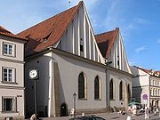
Bethlehem Chapel
Encyclopedia

Prague
Prague is the capital and largest city of the Czech Republic. Situated in the north-west of the country on the Vltava river, the city is home to about 1.3 million people, while its metropolitan area is estimated to have a population of over 2.3 million...
, Czech Republic
Czech Republic
The Czech Republic is a landlocked country in Central Europe. The country is bordered by Poland to the northeast, Slovakia to the east, Austria to the south, and Germany to the west and northwest....
notable for its connection with the Czech reformer Jan Hus
Jan Hus
Jan Hus , often referred to in English as John Hus or John Huss, was a Czech priest, philosopher, reformer, and master at Charles University in Prague...
. It was founded in 1391 by Wenceslas Kriz (known as 'the Merchant'), and John of Milheim, and taught solely in the Czech vernacular, thus breaking with German domination of the Medieval Bohemian church. The building was never officially called as a church, only a chapel
Chapel
A chapel is a building used by Christians as a place of fellowship and worship. It may be part of a larger structure or complex, such as a church, college, hospital, palace, prison or funeral home, located on board a military or commercial ship, or it may be an entirely free-standing building,...
, though it could contain 3,000 people; indeed, the chapel encroached upon the parish of Sts. Philip and James, and John of Milheim paid the pastor of that church 90 grossi as compensation.
Hus became rector and preacher in March, 1402. After Hus's excommunication in 1412, the Pope ordered the Bethlehem chapel to be pulled down, although this action was rejected by the Czech majority on the Old Town council. After Hus's death, he was succeeded by Jacob of Mies
Jacob of Mies
Jacob of Mies was a Bohemian reformer, and colleague of Jan Hus. Jacob was born in 1372 in Mies , west of Pilsen, Bohemia, now in Czechia....
.
In the 17th century, the building was acquired by the Jesuits. During reign of the Emperor Joseph II
Joseph II, Holy Roman Emperor
Joseph II was Holy Roman Emperor from 1765 to 1790 and ruler of the Habsburg lands from 1780 to 1790. He was the eldest son of Empress Maria Theresa and her husband, Francis I...
(1780s) it was converted into an apartment building. Under the Czechoslovakian communist regime the building was restored by the government to its state at the time of Hus. Most of the chapel's exterior walls and a small portion of the pulpit date back to the medieval chapel. The wall paintings are largely from Hus's time there, and the text below is taken from his work De sex erroribus, and contrast the poverty of Christ with the riches of the Catholic Church of Hus's time.

